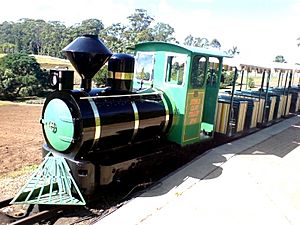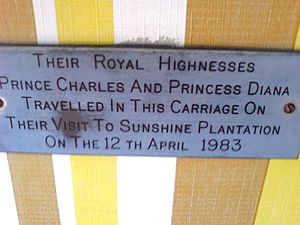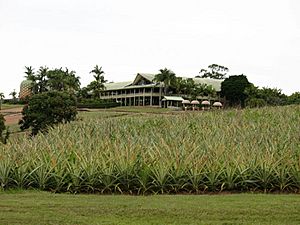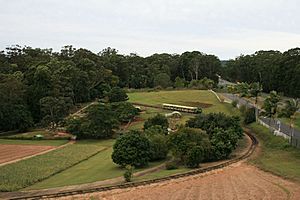Big Pineapple facts for kids
Quick facts for kids Big Pineapple |
|
|---|---|
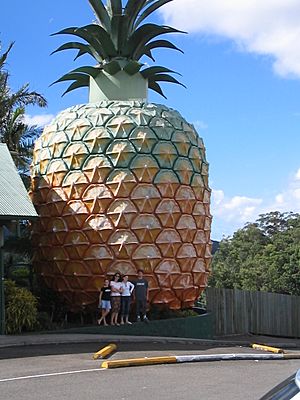
Big Pineapple, 2005
|
|
| Location | Nambour Connection Road, Woombye, Sunshine Coast Region, Queensland, Australia |
| Design period | 1970s–1990s (late 20th century) |
| Built | 1971 |
| Architect | Peddle Thorp and Harvey, Paul Luff, Gary Smallcombe and Associates |
| Official name: The Big Pineapple (former Sunshine Plantation) | |
| Type | state heritage (built, landscape) |
| Designated | 6 March 2009 |
| Reference no. | 602694 |
| Significant period | 1970s |
| Significant components | restaurant, retail outlet |
| Lua error in Module:Location_map at line 420: attempt to index field 'wikibase' (a nil value). | |
The Big Pineapple is a famous tourist spot and a "big thing" located on the Sunshine Coast Region in Queensland, Australia. It was designed by several architects and is also known as Sunshine Plantation. This unique attraction was added to the Queensland Heritage Register in 2009 because of its special history.
The Big Pineapple structure is 16 meters (about 52 feet) tall and has two levels. It first opened its doors on August 15, 1971. The entire site covers a large area of 165 hectares (about 408 acres). Today, new owners are bringing in exciting events like the Big Pineapple Music Festival. They are also planning new attractions to make the Big Pineapple even better for visitors.
Contents
The Big Pineapple's Story
The Big Pineapple, originally called Sunshine Plantation, is a place many people remember fondly. It was a popular stop for families driving north from Brisbane after 1971. This 40-hectare (about 99-acre) complex was one of Queensland's first "agri-tourism" attractions. It combined fun activities with learning about farming.
What are "Big Things"?
"Big Things" are giant objects, usually shaped like something the area is known for. They are often much larger than real life and are used to attract tourists. Think of them as huge advertisements! The Big Pineapple is one of Australia's most famous "Big Things." It helps show what a town or area is all about.
Pineapples were first grown in Queensland in 1824. By the late 1800s, the Maroochy area became a major fruit-growing region. Woombye, where the Big Pineapple is located, was especially known for its pineapples. The railway, built in the 1890s, helped farmers send their fruit to other places.
After World War II, more families started taking road trips in cars. This led to more motels and tourist attractions being built. The Bruce Highway, a major road, was fully paved by 1962, making travel easier. The "Sunshine Coast" became a popular holiday spot, known for its beaches and family-friendly places.
How the Big Pineapple Started
In 1971, Bill and Lyn Taylor bought a pineapple farm near Woombye. They had a new idea: to create an agri-tourism project called Sunshine Plantation. It would show visitors how different tropical fruits, nuts, and sugar cane were grown. The local council and the Queensland Government supported their idea.
The Sunshine Plantation officially opened on August 15, 1971. The 16-meter (52-foot) tall Big Pineapple structure, made of steel and fiberglass, became its symbol. Inside the pineapple, visitors could learn about the pineapple industry. There was also a shop and a restaurant. A special train ride, called the Plantation Train, took visitors on a tour of the farm. This train track is known for having the steepest incline and sharpest bend of any passenger rail track in Queensland.
The attraction quickly became popular. In 1978, a fire destroyed the market and restaurant building. But a new complex was built quickly and opened just two months later. By 1980, the Sunshine Plantation had added a Macadamia Nut Factory and a "Nutmobile" tour. Visitors could see how macadamia nuts were processed.
Royal Visit and Growth
In 1983, King Charles III (then Prince Charles) and Diana, Princess of Wales visited the Big Pineapple. They even rode on the train during their official trip to Australia! This visit helped make the Big Pineapple even more famous.
Throughout the 1980s, the Big Pineapple continued to grow. New car parks were added, and a pedestrian bridge was built over the highway. The Big Pineapple structure itself was moved and refurbished. In 1988, the "Tomorrow's Harvest" greenhouse opened, showing new ways of farming like hydroponics. In 1989, the 16-meter (52-foot) tall Big Macadamia, also known as the Magic Macadamia, was opened.
In 1990, the Bruce Highway was changed, bypassing the Big Pineapple. However, the attraction remained popular and continued to be updated. A mini tornado damaged the Tomorrow's Harvest attraction in 1991, but it was repaired. New features like rainforest walks and a wildlife garden with koalas were added.
The Big Pineapple became a recognized landmark. In 2006, it was chosen as one of 12 "Queensland icons" by the National Trust of Queensland. In 2007, Australia Post even featured the Big Pineapple on one of its stamps, celebrating Australia's "Big Things."
Recent Times and Reopening
The Big Pineapple closed in 2010. However, in 2011, a new group of owners bought the complex. They worked hard to repair the visitor area and bring the attraction back to life.
In April 2013, the first Big Pineapple Music Festival was held. This festival has become very popular and is now a major event in Australia. In 2017, the owners announced plans to add new attractions and services. They saw potential for a family fun park, walking trails, and even tourist accommodation like glamping sites.
As of 2025, the Big Pineapple is home to the heritage-listed visitor area, the Wildlife HQ Zoo, and the popular music festival. Visitors can still climb inside the Big Pineapple. While it might not attract as many visitors as it did in the 1970s and 1980s, interest in the Big Pineapple is still strong. It's even a popular spot for taking selfies!
In September 2020, the sugar cane train was taken out of service for repairs. In May 2021, the train was damaged by someone who took it for a ride without permission. The train system was repaired and reopened in 2024. As of March 2019, the Big Pineapple also hosts the TreeTop Challenge, which is Australia's highest ropes course.
What You Can See
The Big Pineapple complex sits on a hill overlooking the Nambour Connection Road. The main area includes the Big Pineapple structure, an entrance building, and two large buildings with shops and restaurants. There are also train tracks, tour stations, an animal nursery, and a koala enclosure.
The Big Pineapple structure and the main buildings are easy to spot from the road. The entrance building is an open pavilion with a corrugated iron roof.
The Big Pineapple Structure
The Big Pineapple itself is a hollow structure, 16 meters (52 feet) tall. Its outer shell is made of fiberglass, shaped and colored to look like a real pineapple. Inside, it has a steel frame.
You can go inside the Big Pineapple. It has two levels with displays about the pineapple industry and other tropical fruits. There are also hand-painted scenes of pineapple farms and models of factories and trains. On the second floor, you can see old photos and products from the Golden Circle Cannery. From the top, there's a viewing platform where you can look out over the plantation.
Shops and Restaurants
After the ticket booth, you'll find the shop and restaurant buildings. These buildings have a Polynesian style, with large roofs and verandahs. They are two stories tall.
Inside the shop, the ceiling and columns are decorated with bamboo. You'll find various souvenirs and retail counters. The restaurant building is similar but larger, with a kitchen area and plenty of space for dining.
The Plantation Train
East of the main buildings is the train station. The train, called Sugar Cane Train No.4, takes visitors on a tour around the pineapple plantation, orchards, and animal nursery. The track goes through a machinery shed and forms a circuit around the site.
Pineapple Plantation
The pineapple plantation is on a slope within the train circuit. Pineapples are grown in neat rows on raised beds, following the shape of the land.
The Orchard
Beyond the train station is the orchard. Here, you can see different fruit trees like star apple, custard apple, and various citrus trees.
Nutmobile and Rainforest Station
The Nutmobile/Rainforest station is a simple, open pavilion with a timber frame and a corrugated iron roof. It's where the Nutmobile tour starts, taking visitors to explore more of the plantation and rainforest areas.
Why It's Important
The Big Pineapple is listed on the Queensland Heritage Register for several reasons:
- History: It shows how agri-tourism and roadside attractions developed in Queensland. It combined tourism with promoting tropical fruit farming.
- Unique Features: It's a great example of an agri-tourism spot, mixing fun activities with educational displays. The Big Pineapple structure itself is a classic "Big Thing," designed to attract visitors.
- Looks: The Big Pineapple is a landmark that stands out on the hill, offering great views. The plantation's design, with its sloping land and different crops, also creates beautiful scenery.
- Community Connection: It's a well-known place both in Australia and internationally. Many people have fond memories of visiting the Big Pineapple on their road trips. It also had strong ties with local farming communities.
Awards
In 2009, as part of Queensland's 150th birthday celebrations (Q150), the Big Pineapple was named one of the Q150 Icons of Queensland.
Australia's Big Things
Australia has many "Big Things" across the country. Queensland has the most, with 41 listed in a 2004 book. These giant structures often advertise local produce or attractions. The Big Pineapple is one of eight "Big Things" in Queensland that you can actually go inside!
See also
- Australia's Big Things
- List of tramways in Queensland


